2016 Honda Pilot

From the March 2017 issue
When practicality is paramount, all other considerations sit even further back than usual, particularly style. Take three-row crossovers, a genre with space for all manner of considerations. Once you package three rows of seats, plump out the silhouette to maximize interior volume, and pull the beltline low for the sake of visibility, you’re left with a fairly bland template onto which to project your brand’s aesthetics. Not that buyers in the big-crossover class seem discouraged by their vehicles’ sameness—sales success in mainstream segments often requires automakers to color inside the lines. That said, the crossover’s role as a minivan surrogate means that plenty of its passengers will color all over the interior.
When Honda redesigned the Pilot for 2016, it lengthened and lowered the triple-row SUV, shucking the previous generation’s blocky exterior for a softer form that bears more than a passing resemblance to that other paragon of blandness, a minivan. And specifically, Honda’s own activity book, the Odyssey. But both have long been among our favored means of moving large numbers of people and great volumes of junk, and so we lined up a Pilot for a long-haul test. We opted for the ultimate Pilot, the Elite. It came loaded with all-wheel drive, leather, navigation, heated and ventilated front seats, heated second-row captain’s chairs, two sunroofs, a Blu-ray rear-seat entertainment system with HDMI and RCA inputs, and Honda’s full complement of driver-assist features: forward-collision warning with automatic emergency braking, lane-keeping assist, adaptive cruise control, blind-spot monitors, and automatic high-beams. To this hefty load of equipment we added a trailer hitch ($360), roof-rail crossbars ($225), and a rear-bumper appliqué ($70), bringing the total MSRP to $47,955.
With an abundance of space, comfort, and luxury, the Pilot completed its 40,000-mile assignment in just 11 months. It passed through some 20 states and four Canadian provinces in our hands, once piling up more than 7000 miles in a single month.
Those highway miles helped keep our fuel consumption at an average of 22 mpg, outstanding for a 4351-pound bus. Honda redesigned the Pilot’s 3.5-liter V-6, now turning out 280 horsepower and 262 pound-feet of torque, for this generation. Cheaper Pilots back that with a six-speed auto, while the uplevel Touring and Elite trims get a nine-speed.

When new, our Pilot turned in straight-line performance that would beat a Dodge Challenger V-6, with a 6.0-second zero-to-60-mph sprint and 14.6 seconds in the quarter-mile at 95 mph. After 40,000 miles, it slipped a couple of tenths in the quarter, handing the lead back to the muscle coupe. Its braking performance—172 feet to stop from 70 mph new, 178 at the end of the test—places it among the best family haulers, and its 0.81-g skidpad performance improved to 0.84 g on worn tires, giving it an edge over many competitors in shopping-cart-avoidance maneuvers.
Service Timeline:
Easy livin’.
Key:

- Repairs

- Damage

- Maintenance

- Normal Wear

- Oil Additions
December 15, 2015
150 miles: Honda Pilot arrives at C/D headquarters
January 8, 2016
2327 miles: Bridgestone Blizzak DM-V2 winter tires installed
March 17, 2016

9592 miles: First service: oil change, $46
April 13, 2016
10,434 miles: All-season tires remounted
June 20, 2016

21,480 miles: Fix damage from scraping against a pipe in a parking garage. Repair and refinish left-rear quarter panel, replace left-rear wheel-well trim, repair roof-rack rail and bumper cover, $986
June 21, 2016

21,594 miles: Second service, including oil change, tire rotation, and rear-differential-fluid replacement, $242
August 29, 2016

31,198 miles: Change oil, rotate tires, replace cabin and engine air filters, $154
September 2, 2016

31,49 miles: Replace damaged left-rear wheel-well trim, $23
September 13, 2016
32,064 miles: Swap back to winter tires for trip to Montana
November 28, 2016

40,913 miles: Oil change, tire rotation, and inspections, $153
40,914 miles: Long-term test concludes
Its interior is certainly an attractive place to pass the miles. It’s inventive, appealing, and loaded with storage bins, cubbies, depressions, and the like. It literally has storage on top of storage. There’s the usual map pocket along the bottom of the front doors, with a second tier of receptacles above that, and then the door pull on top, which doubles as a shallow storage cubby. And the console between the front seats could swallow a full-grown Lhasa apso with room for a chew toy or two. Visibility all around is excellent. Riding in back and then switching to the driver’s seat made us jealous of the enormous sunroof enjoyed by back-seat passengers, though the entertainment screen that flips down from the ceiling is so small that it might be contributing to the myopia outbreak in today’s children.
The second-row captain’s chairs fold and slide forward at the touch of a button, offering wide passage to the distant rear seats. Unlike some systems that power the seat forward slowly, the Pilot’s have an electronic actuator, and they slide forward with a satisfying, spring-loaded mechanical quickness. One staffer called them “a game changer.” In back, we found so much space that even our lankiest lunks had sufficient headroom. The trade-off is that if all seven seats are occupied, there’s barely space for each passenger to pack a lunchbox between the third-row seatbacks and the power rear hatch. Now that the Pilot looks even more like the Odyssey, the storage sting feels especially sharp. The Odyssey allots an extra 20 cubic feet each to people and stuff.
Our Pilot did its part to continue Honda’s reputation for trouble-free ownership. It required zero unscheduled service visits, and the total for four visits at 10,000-mile intervals squeezed in at less than $600. However, we also did our part to continue our reputation by twice backing the big Honda into things. The first time, a pipe in a parking garage skewered the left-rear quarter panel. The subsequent metalwork and some new plastic trim pulled $986 out of our indiscretionary spending account. Not even three months later, a post ambushed the same corner, but this time the damage was less. A new plastic trim piece cost only $23.

As satisfying as the Pilot is when stationary, the logbook was filled with numerous, er, off-color comments. Honda found a startling array of fussy ways to make the Pilot call negative attention to itself. The annoyances begin before you even start driving, with a nonsensical push-button shifter in which park and neutral are the same size buttons in different planes, drive is a different size and shape (and nested at an angle in a chrome trim ring), and reverse is a pull switch. That these buttons and switches take up precisely as much space on the console as a regular shifter won them no friends.
And yet, while the Pilot is naturally predisposed to road trips, every staffer who’s driven Honda’s Ridgeline—with which the Pilot shares its underpinnings—has climbed out of the pickup and wondered aloud why Honda doesn’t offer its firmer suspension in the Pilot. The looser Pilot occasionally feels as if it’s manufacturing its own crosswinds. There’s plenty of fore and aft bobbing, too, thanks to the adaptive cruise control’s abrupt braking. The system also hunts endlessly through the gears and often accelerates well beyond its set speed, meaning that few drivers left the active function engaged.
Around town, the throttle and transmission calibrations are so jumpy that several of us took to driving the Pilot in economy mode for the more tolerable, relaxed programming. Similarly, the engine stop-start system’s logic lags its peers, on several occasions shutting the engine off in the middle of parallel-parking maneuvers. These are commodity systems now—they should be simple and intuitive. That good examples are found in economy cars but not in a nearly $50,000 Honda is supremely disappointing.
Nearly every mainstream car brand in the U.S. today sells a three-row crossover, giving the Pilot about a dozen direct competitors. If you stretch a few grand beyond the extremes of the Pilot’s pricing spectrum, it has about that many indirect competitors, too. Few are as attractively finished as the Pilot, and fewer still are likely to offer such an affordable ownership experience. But most share its core competencies, and few are as annoying in full trim. The Pilot is a good crossover; the Pilot Elite is a good crossover overwhelmed by the very thing an activity book is supposed to alleviate: fussiness.

Rants and Raves
Is the cruise-control system messed up, or does it just suck? —Rusty Blackwell
How did this throttle calibration ever leave the proving ground? Low-speed and standing-start responses are as bad as I’ve driven. —Josh Jacquot
The one-touch sliding second-row seats are a game changer for parents of small children. —Dave VanderWerp
The primary controls were clearly secondary concerns. The brake pedal is too soft, and the throttle is too touchy at tip-in. —Eric Tingwall
Almost like a pickup in that the ride quality improves when it’s loaded down. —Joseph Capparella
If only there were knobs and physical buttons for the infotainment system. —Jennifer Harrington
There are way too many annoyances here for me to recommend this vehicle to anyone. —John Phillips
Specifications >
VEHICLE TYPE: front-engine, all-wheel-drive, 7-passenger, 4-door hatchback
PRICE AS TESTED: $47,955 (base price: $47,300)
ENGINE TYPE: SOHC 24-valve V-6, aluminum block and heads, direct fuel injection
Displacement: 212 cu in, 3471 cc
Power: 280 hp @ 6000 rpm
Torque: 262 lb-ft @ 4700 rpm
TRANSMISSION: 9-speed automatic with manual shifting mode
DIMENSIONS:
Wheelbase: 111.0 in
Length: 194.5 in
Width: 78.6 in Height: 70.4 in
Passenger volume: 153 cu ft
Cargo volume: 16 cu ft
Curb weight: 4351 lb
PERFORMANCE: NEW
Zero to 60 mph: 6.0 sec
Zero to 100 mph: 16.7 sec
Zero to 110 mph: 21.1 sec
Rolling start, 5–60 mph: 6.2 sec
Top gear, 30–50 mph: 3.5 sec
Top gear, 50–70 mph: 4.6 sec
Standing ¼-mile: 14.6 sec @ 95 mph
Top speed (governor limited): 113 mph
Braking, 70–0 mph: 172 ft
Roadholding, 300-ft-dia skidpad: 0.81 g*
PERFORMANCE: 40,000 MILES
Zero to 60 mph: 6.0 sec
Zero to 100 mph: 16.9 sec
Zero to 110 mph: 21.7 sec
Rolling start, 5–60 mph: 6.3 sec
Top gear, 30–50 mph: 3.5 sec
Top gear, 50–70 mph: 4.7 sec
Standing ¼-mile: 14.8 sec @ 95 mph
Top speed (governor limited): 113 mph
Braking, 70–0 mph: 178 ft
Roadholding, 300-ft-dia skidpad: 0.84 g*
FUEL ECONOMY:
EPA combined/city/hwy: 22/19/26 mpg
C/D observed: 22 mpg
Unscheduled oil additions: 0 qt
WARRANTY:
3 years/36,000 miles bumper to bumper;
5 years/60,000 miles powertrain;
5 years/unlimited miles corrosion protection;
3 years/36,000 miles roadside assistance
*Stability-control-inhibited.
WHAT WE LIKE: Seats this comfortable encourage long-distance drives, especially when they’re heated and ventilated, and the Pilot’s 280-hp V-6 makes merging into any traffic just a squirt of gas away. After nearly a year, the styling is starting to grow on some of us. Well, as long as we hold a hand over one eye so we don’t have to look at the minivan-esque nose. But we’ve been noticing some previous-generation versions around. Remember how bizarre they looked?
WHAT WE DON’T LIKE: The variety of ways Honda has found to make the fundamentally inoffensive notion of a three-row crossover illogical and weird. The stop/start system continues to win detractors, its unpredictable behavior meaning that it spends most of its time disabled. Ditto the adaptive cruise-control system, which we tend to turn off so that we have regular old cruise control—which still allows a startling discrepancy between set speed and actual speed. And the throttle mapping, which is so abrupt that we’ve been toggling the system to Econ mode to soften powertrain response. It always sounded exciting to crawl into a race car and have to flip a bunch of switches—for the fuel pump, fan, water pump, et cetera—before pressing the start button. When that sequence is reversed and, after starting, you have to hunt around for buttons to disable a bunch of unsatisfactory systems, it’s a lot less cool.
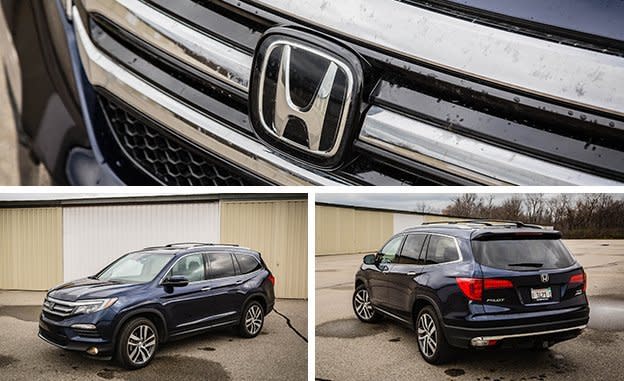
WHAT WENT WRONG: Hey, nobody ran the Pilot into anything in the past few months! We did carefully drive it to the dealer for a routine 30,000-mile service (oil change, tire rotation, filters for the engine and cabin), which cost $154. More notably, the Pilot was recruited to rescue creative director Darin Johnson when the Land Rover he bought for our off-road beater challenge started making ominous noises 200 miles from home. However, when he arrived at the U-Haul lot to rent a trailer, he realized that although the Pilot has a trailer hitch, it does not have a wiring harness for a trailer. Which is good, because our Pilot also lacks the transmission cooler that would raise the tow rating anywhere near what one needs to accommodate a Land Rover on a U-Haul car trailer. Ever notice how sturdy those things are? Seriously overbuilt. Our Pilot’s hitch, on the other hand, must be intended for 3500 pounds of bicycle racks.
WHERE WE WENT: We haven’t gone anywhere. If we’re being honest, we’ve felt stagnant for a while, like it’s the same grind with different beans, day in and day out. Oh, you mean the Pilot? It’s now out in Montana, spending its last few thousand miles on wild adventures with John Phillips, exploring the deepest reaches of the Bitterroot Mountains and parking-lot corners nearest the tavern’s front door. By the time the Honda makes its way home to Ann Arbor, its 40,000 miles should just about be at their end.
Months in Fleet: 11 months Current Mileage: 36,367 miles
Average Fuel Economy: 22 mpg Fuel Tank Size: 19.5 gal Fuel Range: 425 miles
Service: $442 Normal Wear: $0 Repair: $0
Damage and Destruction: $986
Specifications >
VEHICLE TYPE: front-engine, all-wheel-drive, 7-passenger, 4-door hatchback
PRICE AS TESTED: $47,955 (base price: $47,300)
ENGINE TYPE: SOHC 24-valve V-6, aluminum block and heads, direct fuel injection
Displacement: 212 cu in, 3471 cc
Power: 280 hp @ 6000 rpm
Torque: 262 lb-ft @ 4700 rpm
TRANSMISSION: 9-speed automatic with manual shifting mode
DIMENSIONS:
Wheelbase: 111.0 in
Length: 194.5 in
Width: 78.6 in Height: 70.4 in
Passenger volume: 153 cu ft
Cargo volume: 16 cu ft
Curb weight: 4351 lb
PERFORMANCE: NEW
Zero to 60 mph: 6.0 sec
Zero to 100 mph: 16.7 sec
Zero to 110 mph: 21.1 sec
Rolling start, 5–60 mph: 6.2 sec
Top gear, 30–50 mph: 3.5 sec
Top gear, 50–70 mph: 4.6 sec
Standing ¼-mile: 14.6 sec @ 95 mph
Top speed (governor limited): 113 mph
Braking, 70–0 mph: 172 ft
Roadholding, 300-ft-dia skidpad: 0.81 g*
PERFORMANCE: 40,000 MILES
Zero to 60 mph: 6.0 sec
Zero to 100 mph: 16.9 sec
Zero to 110 mph: 21.7 sec
Rolling start, 5–60 mph: 6.3 sec
Top gear, 30–50 mph: 3.5 sec
Top gear, 50–70 mph: 4.7 sec
Standing ¼-mile: 14.8 sec @ 95 mph
Top speed (governor limited): 113 mph
Braking, 70–0 mph: 178 ft
Roadholding, 300-ft-dia skidpad: 0.84 g*
FUEL ECONOMY:
EPA combined/city/hwy: 22/19/26 mpg
C/D observed: 22 mpg
Unscheduled oil additions: 0 qt
WARRANTY:
3 years/36,000 miles bumper to bumper;
5 years/60,000 miles powertrain;
5 years/unlimited miles corrosion protection;
3 years/36,000 miles roadside assistance
*Stability-control-inhibited.
WHAT WE LIKE: Our observed fuel economy is inching upward through summer road-trip season, hitting an average of 22 mpg. When those trips have included more than four people, we’ve come to appreciate the second-row seats, which allow third-row access by folding their seatbacks and sliding the assembly forward at the push of a button located on either the seatback (for third-row passengers) or the side cushion (for those outside the vehicle). And we’ve found that once the Pilot is loaded, its ride quality improves, settling somewhat from its unladen floatiness.
WHAT WE DON’T LIKE: Using the third row for people means there’s precious little space available for those people’s things. It’s a complaint common to nearly all three-row crossovers—and probably the Pilot’s greatest drawback compared with its Odyssey minivan sibling. With the third row raised, there’s just 16 cubic feet of luggage space; the Odyssey can carry 38 cubic feet of luggage.
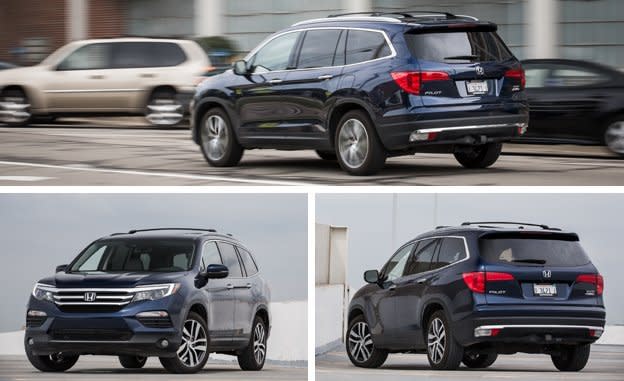
Jumpy throttle and transmission calibrations are exacerbated by a lousy adaptive cruise control that seems incapable of smooth speed adjustments—and occasionally rushes well above the set speed. But at least you can turn that off and just have regular, non-adaptive cruise control. The auto stop/start system, too, has come under fire for incomprehensible logic, sometimes turning off the engine only after sitting for a long period and at least once shutting it down in the midst of a parking maneuver.
WHAT WENT WRONG: Barely a month after we fixed the damage done to our left-rear quarter-panel in a parking garage, someone backed the same corner into a post on a narrow, winding driveway. Again the bumper cover was scuffed, and again the plastic wheel-well trim was rumpled. We haven’t fixed it yet—and may not, as evidence suggests we can’t be trusted with nice things. But if anyone damages that corner again, we might start looking for a way to blame Honda. We’ve had only one more regular service visit, an oil change, air-filter swap, and inspection that cost $154.
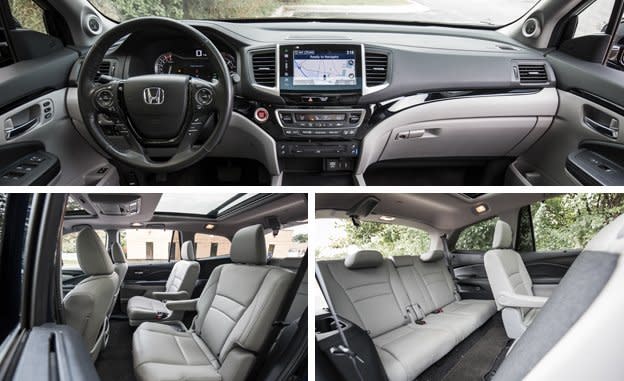
WHERE WE WENT: Its road-trip aptitude means the Pilot has been in high demand for the summer Michigan ritual of weekly trips north, hitting destinations in Gaylord and Muskegon, as well as more-southerly spots like Dollywood and Canada. After passing through Windsor, Ontario—which is indeed south of Detroit—technical director Eric Tingwall ended up in Quebec, where he noted that “even the French-speaking locals make more sense than Honda’s infotainment system.” But other staffers are warming to the touchscreen system, with associate online editor Joseph Capparella going so far as to wonder why more automakers don’t outsource their navigation software (Honda’s comes from Garmin).
Months in Fleet: 8 months Current Mileage: 25,962 miles
Average Fuel Economy: 22 mpg Fuel Tank Size: 19.5 gal Fuel Range: 425 miles
Service: $288 Normal Wear: $0 Repair: $0
Damage and Destruction: $986
Specifications >
VEHICLE TYPE: front-engine, all-wheel-drive, 7-passenger, 4-door hatchback
PRICE AS TESTED: $47,955 (base price: $47,300)
ENGINE TYPE: SOHC 24-valve V-6, aluminum block and heads, direct fuel injection
Displacement: 212 cu in, 3471 cc
Power: 280 hp @ 6000 rpm
Torque: 262 lb-ft @ 4700 rpm
TRANSMISSION: 9-speed automatic with manual shifting mode
DIMENSIONS:
Wheelbase: 111.0 in
Length: 194.5 in
Width: 78.6 in Height: 70.4 in
Passenger volume: 153 cu ft
Cargo volume: 16 cu ft
Curb weight: 4351 lb
PERFORMANCE: NEW
Zero to 60 mph: 6.0 sec
Zero to 100 mph: 16.7 sec
Zero to 110 mph: 21.1 sec
Rolling start, 5–60 mph: 6.2 sec
Top gear, 30–50 mph: 3.5 sec
Top gear, 50–70 mph: 4.6 sec
Standing ¼-mile: 14.6 sec @ 95 mph
Top speed (governor limited): 113 mph
Braking, 70–0 mph: 172 ft
Roadholding, 300-ft-dia skidpad: 0.81 g*
PERFORMANCE: 40,000 MILES
Zero to 60 mph: 6.0 sec
Zero to 100 mph: 16.9 sec
Zero to 110 mph: 21.7 sec
Rolling start, 5–60 mph: 6.3 sec
Top gear, 30–50 mph: 3.5 sec
Top gear, 50–70 mph: 4.7 sec
Standing ¼-mile: 14.8 sec @ 95 mph
Top speed (governor limited): 113 mph
Braking, 70–0 mph: 178 ft
Roadholding, 300-ft-dia skidpad: 0.84 g*
FUEL ECONOMY:
EPA combined/city/hwy: 22/19/26 mpg
C/D observed: 22 mpg
Unscheduled oil additions: 0 qt
WARRANTY:
3 years/36,000 miles bumper to bumper;
5 years/60,000 miles powertrain;
5 years/unlimited miles corrosion protection;
3 years/36,000 miles roadside assistance
*Stability-control-inhibited.
WHAT WE LIKE: The space inside the Honda Pilot makes it ideal for hauling all manner of people and stuff. The numerous cubbies are proving especially popular. After driving it to Breaks, Virginia, for a 24-hour adventure race—which sounds to the rest of the staff like a great way to spoil an otherwise lovely weekend in Virginia—tech director Eric Tingwall wrote an ode to the Pilot’s center console: “It’s big enough to stash tens of thousands of calories of snack foods, but not so deep that they disappear into a dark hole never to be recovered. And when it’s time to feast, you close that tambour door and use it as a serving tray, never worrying that something will slide off, because the door is slightly recessed below the edges of the console.” Beyond the Pilot’s usefulness as a mobile snack center, the Honda’s 21 mpg in our hands is pretty good for a seven-seater.
WHAT WE DON’T LIKE: The push-button shifter is maddening and silly. Given how much space is allotted to those buttons, why isn’t it just a regular shifter? Instead, there are buttons of different sizes and shapes situated in different planes for different functions. Push a button for park, drive, or neutral, but to engage reverse, you tug on a switch. And, since the Pilot so strongly resembles a minivan now, the packaging compromises relative to the Odyssey are that much more frustrating. But maybe, as designers try to pack more space into crossovers built on car and minivan platforms, crossovers will slowly start to morph back into their original shapes, and we’ll see a slow migration of buyers toward the uncompromised practicality of the hatchback and the minivan. Or perhaps not.

WHAT WENT WRONG: In the sort of Washington, D.C., parking garage where you might expect to find a Law & Order villain lurking in the shadows, one of our contributors encountered a far more real menace: a pipe obscured by a support column. The pipe scraped along the left-rear fender, with the damage fortunately confined largely to the plastic trim piece around the wheel well, although it did dig into the quarter-panel and the bumper cover. Had more metal been damaged, the bill undoubtedly would have been higher than the $986 the mishap cost us. Our 10,000-mile service, an oil change and inspection, came to just $46; our second service, at 20,000 miles, added a tire rotation and a change of the rear differential’s fluid and set us back $242.
WHERE WE WENT: It was a busy May and June for the Pilot. Copy chief Carolyn Pavia-Rauchman and her family used it to cross the Kentucky Derby off their bucket list. It was home for just a few days before heading down to Washington, D.C. From there, it proceeded to the northern reaches of Michigan and then went straight into a return trip to Virginia, shuttling people and gear to C/D’s Lightning Lap X (coming in the October issue!). On the return trip, it detoured through New Brunswick and Nova Scotia, for reasons we’re not quite sure about. By the time it returned from this trip, it had accumulated more than 7000 miles in just one month. We don’t expect the remaining 20,000 to pass quite as quickly, but the Pilot is reserved for road trips most weekends between now and the end of August.
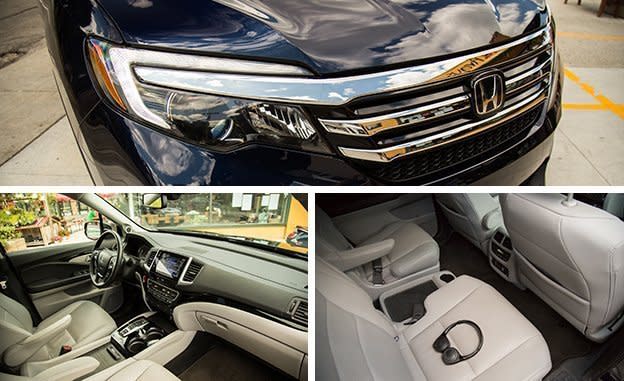
Months in Fleet: 6 months Current Mileage: 16,672 miles
Average Fuel Economy: 21 mpg Fuel Tank Size: 19.5 gal Fuel Range: 405 miles
Service: $288 Normal Wear: $0 Repair: $0
Damage and Destruction: $986
Specifications >
VEHICLE TYPE: front-engine, all-wheel-drive, 7-passenger, 4-door hatchback
PRICE AS TESTED: $47,955 (base price: $47,300)
ENGINE TYPE: SOHC 24-valve V-6, aluminum block and heads, direct fuel injection
Displacement: 212 cu in, 3471 cc
Power: 280 hp @ 6000 rpm
Torque: 262 lb-ft @ 4700 rpm
TRANSMISSION: 9-speed automatic with manual shifting mode
DIMENSIONS:
Wheelbase: 111.0 in
Length: 194.5 in
Width: 78.6 in Height: 70.4 in
Passenger volume: 153 cu ft
Cargo volume: 16 cu ft
Curb weight: 4351 lb
PERFORMANCE: NEW
Zero to 60 mph: 6.0 sec
Zero to 100 mph: 16.7 sec
Zero to 110 mph: 21.1 sec
Rolling start, 5–60 mph: 6.2 sec
Top gear, 30–50 mph: 3.5 sec
Top gear, 50–70 mph: 4.6 sec
Standing ¼-mile: 14.6 sec @ 95 mph
Top speed (governor limited): 113 mph
Braking, 70–0 mph: 172 ft
Roadholding, 300-ft-dia skidpad: 0.81 g*
PERFORMANCE: 40,000 MILES
Zero to 60 mph: 6.0 sec
Zero to 100 mph: 16.9 sec
Zero to 110 mph: 21.7 sec
Rolling start, 5–60 mph: 6.3 sec
Top gear, 30–50 mph: 3.5 sec
Top gear, 50–70 mph: 4.7 sec
Standing ¼-mile: 14.8 sec @ 95 mph
Top speed (governor limited): 113 mph
Braking, 70–0 mph: 178 ft
Roadholding, 300-ft-dia skidpad: 0.84 g*
FUEL ECONOMY:
EPA combined/city/hwy: 22/19/26 mpg
C/D observed: 22 mpg
Unscheduled oil additions: 0 qt
WARRANTY:
3 years/36,000 miles bumper to bumper;
5 years/60,000 miles powertrain;
5 years/unlimited miles corrosion protection;
3 years/36,000 miles roadside assistance
*Stability-control-inhibited.
Honda’s Pilot has been among our favorite ways to move lots of people and gear ever since it first appeared shortly after the dawn of the century. And we’ve also always liked the Odyssey minivan, so when the new Pilot debuted for 2016 looking an awful lot like the Odyssey, we immediately put in our order for a long-termer. (Okay, we probably would have wanted one no matter what it looked like.)
There are Odyssey bones beneath that Odyssey-aping skin, but there’s also a new, 280-hp V-6 paired with the first nine-speed automatic ever to pass through our long-term fleet. The nine-speed is standard on the Touring and the top-of-the-line Elite trim levels.
We chose that latter because it comes with a two-place second row that limits occupancy to seven persons—and then only if the three of them in the rearmost seat typically state their ages by holding up fingers. We have concluded that this is the maximum occupancy threshold for maintaining driver sanity.
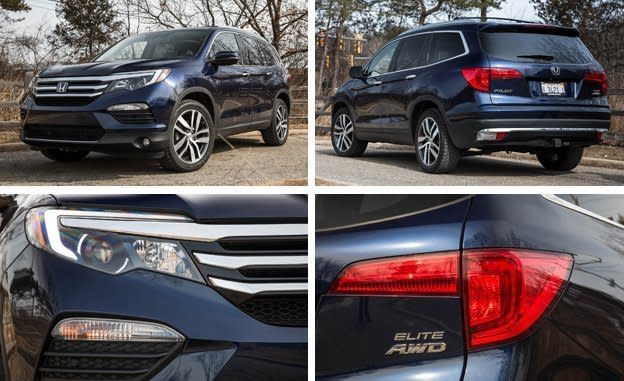
At a base price of $31,045, an entry-level front-wheel-drive Pilot LX includes a rearview camera, push-button start, a tilting and telescoping steering column, and a stereo that includes Bluetooth and USB connectivity. By the time you’ve ascended to the penultimate $42,070 Touring, you’ve added remote starting, second-row seats that fold at the touch of a button, three-zone automatic climate control, LED ambient lighting, a 10-way power-adjustable driver’s seat, four additional USB ports (for a total of three in the front and two in the second row), leather upholstery, navigation, and a Blu-ray rear-seat entertainment system. The last step up to Elite adds all-wheel drive, heated and cooled front seats, heated rear seats, an extra-large sunroof, and the most feature-heavy version of the Honda Sensing package. Highlights of the latter package are forward-collision warning with automatic braking, blind-spot monitoring, and lane-keeping assist. The total price came to $47,955 after accessories such as a trailer-hitch receiver and roof-rail crossbars were tacked on.
Elite, but Unlucky
We wanted to divert attention from our Pilot’s dad-mobile profile and toward its top-tier status with a vanity plate, “L337,” (see Urban Dictionary if you’re confused) but our loan agreements with auto manufacturers don’t allow it. Too bad, since that might have avoided the awkwardness that followed when we got a parking ticket in the Pilot, went to pay it, and learned just how many people have received and not paid Ann Arbor parking tickets on Honda press vehicles wearing California manufacturer plates beginning in 3421. (For the record, we’re not the only publication in the neighborhood.)
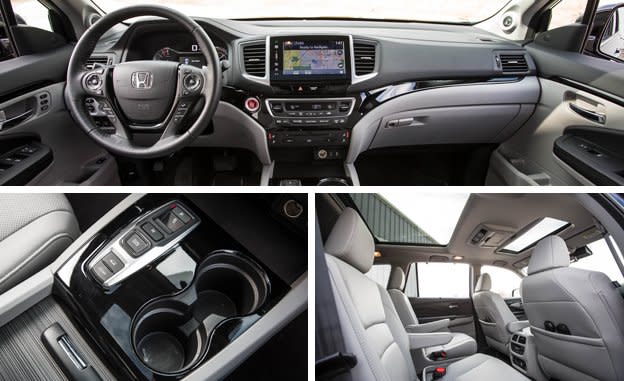
Aside from that ticket, we’ve incurred no expenses in the Pilot beyond the cost of fuel, which it currently consumes at a rate of one gallon every 21 or so miles. For a luxury-packed seven-seater weighing 4351 pounds, that’s not so bad. On its initial test outing, it hit 60 mph in 6.0 seconds and blitzed the quarter-mile in 14.6 at 95 mph, which will best a V-6 Dodge Challenger. Skidpad grip of 0.81 g is reasonable for the class, and its 172-foot stopping distance from 70 mph places the Honda among the best family haulers.
Subjective aspects that are so far earning praise include seat comfort in the first two rows (nobody old enough to speak complete sentences has yet been convinced to spend sufficient time in the way-back to comment) and a serene highway ride. Negative logbook comments have focused on the infuriating touchscreen infotainment system and a short-sighted adaptive-cruise-control system that brakes abruptly and allows speed to fluctuate more than most systems, including going well beyond the set speed when accelerating. As summer road-trip season gets into full swing here in the next few months, we’ll find plenty more to love and loathe.
Months in Fleet: 4 months Current Mileage: 7740 miles
Average Fuel Economy: 21 mpg Fuel Tank Size: 19.5 gal Fuel Range: 410 miles
Service: $0 Normal Wear: $0 Repair: $0
Specifications >
VEHICLE TYPE: front-engine, all-wheel-drive, 7-passenger, 4-door hatchback
PRICE AS TESTED: $47,955 (base price: $47,300)
ENGINE TYPE: SOHC 24-valve V-6, aluminum block and heads, direct fuel injection
Displacement: 212 cu in, 3471 cc
Power: 280 hp @ 6000 rpm
Torque: 262 lb-ft @ 4700 rpm
TRANSMISSION: 9-speed automatic with manual shifting mode
DIMENSIONS:
Wheelbase: 111.0 in
Length: 194.5 in
Width: 78.6 in Height: 70.4 in
Passenger volume: 153 cu ft
Cargo volume: 16 cu ft
Curb weight: 4351 lb
PERFORMANCE: NEW
Zero to 60 mph: 6.0 sec
Zero to 100 mph: 16.7 sec
Zero to 110 mph: 21.1 sec
Rolling start, 5–60 mph: 6.2 sec
Top gear, 30–50 mph: 3.5 sec
Top gear, 50–70 mph: 4.6 sec
Standing ¼-mile: 14.6 sec @ 95 mph
Top speed (governor limited): 113 mph
Braking, 70–0 mph: 172 ft
Roadholding, 300-ft-dia skidpad: 0.81 g*
PERFORMANCE: 40,000 MILES
Zero to 60 mph: 6.0 sec
Zero to 100 mph: 16.9 sec
Zero to 110 mph: 21.7 sec
Rolling start, 5–60 mph: 6.3 sec
Top gear, 30–50 mph: 3.5 sec
Top gear, 50–70 mph: 4.7 sec
Standing ¼-mile: 14.8 sec @ 95 mph
Top speed (governor limited): 113 mph
Braking, 70–0 mph: 178 ft
Roadholding, 300-ft-dia skidpad: 0.84 g*
FUEL ECONOMY:
EPA combined/city/hwy: 22/19/26 mpg
C/D observed: 22 mpg
Unscheduled oil additions: 0 qt
WARRANTY:
3 years/36,000 miles bumper to bumper;
5 years/60,000 miles powertrain;
5 years/unlimited miles corrosion protection;
3 years/36,000 miles roadside assistance
*Stability-control-inhibited.

 Yahoo Finance
Yahoo Finance 